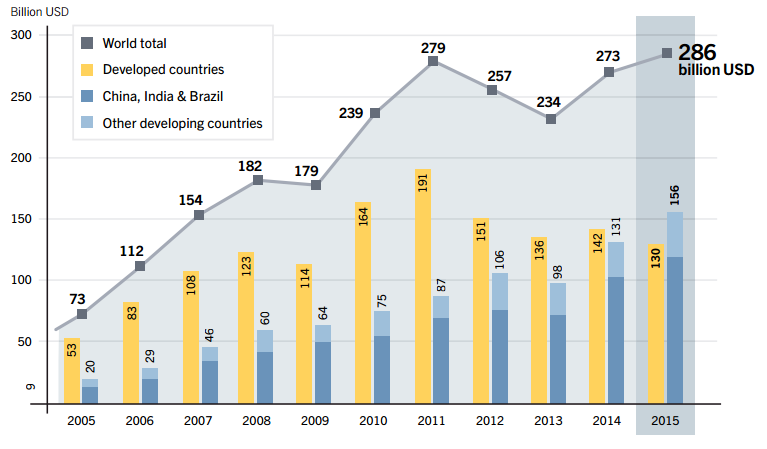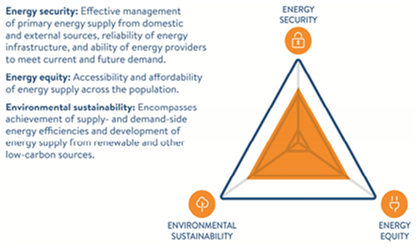By: Hilman Syahri Fathoni
A recent study by Ren21 shows that there was a higher investment trend in the renewable energy sector by developing countries compared to their developed ones (see Figure 1). It showed a total of about USD 286 billion which represented the highest number ever recorded in regards to the renewable sector investment. However, there was the opposite shrinking pattern of investment in developed countries, specifically in Europe, where markets have a fast-growing renewable energy.

Figure 1. The amount of investment in the renewable sector in renewable sector (Global Status Report 2016 by Ren21)
The World Energy Council’s Trilemma Index also provides the other way to look at how the future might look like for developing countries in achieving sustainable energy development. The result shows predominantly more developed countries on the top spots, alluding to complex trade-offs and limitations felt by developing countries which might hinder the development of well-balanced policies. In general, it takes into account three core dimensions: energy security, energy equity (accessibility and affordability) and environmental sustainability. Those parameters determine the overall performance of a country regarding the trilemma presented in the index (see Figure 2).

Asia is a good example of the region to see developing countries’ attempt in facing the future sustainable energy development. The continent hosts some of the world’s rapidly growing economies such as China, India, and Indonesia. Their energy demands are soaring while poverty, environmental degradation, and infrastructure deficiency are ubiquitous. Many countries in the Asian region rank in the lower half of the Trilemma Index which indicates the struggle of balancing between improving accesses to affordable energy and maintaining environmental sustainability. An exception, however, is made for the Philippines. It scored highly in the environmental sustainability aspect due to an increased number of electricity generated from non-hydropower renewable energy sources, which is around 15%. However, there is still a considerable challenge in the Philippines where energy security and energy access remain problematic. Thus, while increasing more renewable energy into the system might seem to be a plausible answer, but there are still many criticisms in several cases (see also Finley-Brook and Thomas, 2013).
Boosting sustainable energy: There is no such a thing called a panacea
There are different solutions to improve problems in sustainable energy. When deciding what kind of energy technologies that will work to meet long-term goals, developing countries found themselves in difficulties, particularly inside the high price circumstance. This typically leads to the economic competitiveness takes over other factors such as secured energy supply and environmental consideration, quite notably in the region where capitals and resources are inadequate. The recent increase in investment in renewable energy in many developing countries indicates the positive attitude to the importance of finance as an opening step to the proliferation of technological installment. Developed countries can also contribute by stepping in with more financial back-up especially in advanced research that aims to make technology more affordable for their developing counterparts. The increase of financial support that allows clean and renewable energy to grow, thus, should always be upheld as one of the priorities for developing countries.
Affordability and accessibility are vital for meeting energy equity performance and addressing both simultaneously require major efforts from every stakeholder in developing countries. Investment in infrastructure combined with innovation in distribution strategy must be enabled to achieve accessible energy for all. While subsidies can potentially be an answer to energy affordability, numerous studies have shown its long-term implementation that will disadvantage nation’s fiscal, societal and environmental cost.
The reform on energy policy is also essential to the improvement of sustainable energy development in developing countries. The thorough analysis of policy effectiveness, especially in the case of numerous cases of misplaced subsidies, can provide a clearer picture for developing countries of common pitfalls they might be unaware of. Commissioning new energy players and first-hand engagement with potentially affected societies might also give guidance to the upcoming innovation and adjustment in future policies. Negligence towards local engagement will rarely work out well, as proven by ample cases of people’s rejection of various energy projects. Furthermore, it is also the government’s imperative to deliver an inclusive approach towards sustainability itself. When considering a future target and policy, the government should mull over the variety of spectrums, from technical, social, to environmental aspects in the pursuit of engendering more sustainable yet integrated welfare benefits.
After all, the historic moment of SDGs birth and the sealing of COP21 agreement heralded another important milestone for the world to the future of sustainable energy development. As we all move on from unfortunate dismissal in Millennium Development Goals, energy should become one of the primary concerns for nations to work their way to achieve a better future. Particularly in the developing world where millions of vulnerable communities are deprived of the joy of having basic electricity, surrendering amidst the cover of haze, and living dangerously in the sight of climate change eyes, then sustainable energy should be one of the fundamentals that underpin its future development agenda.
*This opinion piece is the author’s own and does not necessarily represent PYC.






